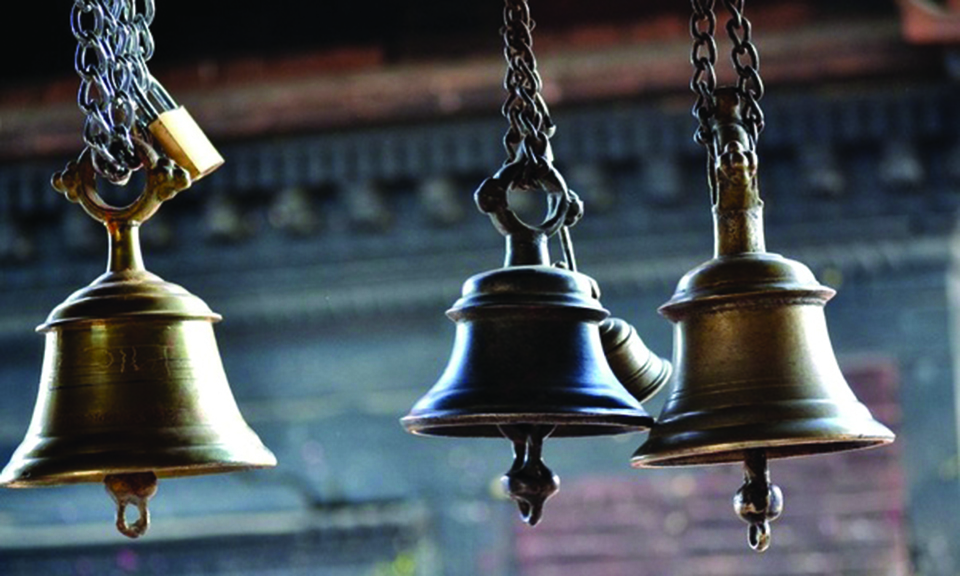
OR


Usha Pokharel
Usha Pokharel is an educationist and author of several children’s books.usha@pokharel.net
The sound of the bell breaks the train of thoughts of a person and helps to focus the mind and make it more receptive
Here goes a Sanskrit verse about the bell: Aagamaarthamtu devaanaam gamanaarthamtu rakshasaam, Kurve ghantaaravam tatra devataahvaahna lakshanam. This means: I ring this bell indicating the invocation of divinity, so that virtuous and noble forces enter; and the demonic and evil forces, from within and without, depart.
As with all other things, there is a mantra associated with ringing of bell. I know you are thinking, ‘why on earth am I writing about Ghanta of all the topics available?’ There is a reason behind it. No, it is nothing to do with parenting, but is linked to it. The actual reason for my writing about Ghanta is in response to the numerous questions from children asking, ‘why do we ring a Ghanta while doing puja and while visiting temples?’ I am sure most of us did not think of asking this question as a child. I remember asking my father and he casually told me that it was to wake people up and remind them to pray.
I was too small to question more about it. It made perfect sense to me at the time. I did not realize that there could be other reasons for ringing the bell. Later when I was confronted with the question again, I realized like me, not many parents might be prepared to answer that question for their children. So, I am writing about it.
Story of the bell
Ghanta as you know is the Sanskrit term for bell. We have all seen different forms of Ghanta. Some are big, placed in temples and some the handheld kind used for our daily puja at home. Ghantas placed in temples can also vary in size but the function is the same. If you have noticed, the sound of the ones placed in the temples is a bit different than the ones we use at home. The big ones make a resounding sound almost like ‘Om’. If you have noticed there is always a Ghanta placed at the entrance of a temple that people ring before entering the temple. When I was a little older, I thought that by ringing the bell I was announcing my arrival. That made sense to me. Later, I thought this could not be right. It certainly had to be something else. I did not want to ask about it again to my father. So, I looked for other sources as well to satisfy my curiosity. Here I am sharing one story that I heard from an old lady in Banaras.
The incident mentioned in the story is placed before the battle of Mahabharata. As we all know, Lord Krishna supported the Pandavas during the famous battle of Mahabharata. So, it is not unusual to find him looking for support in the war. In the process, he went to seek the support of a powerful King. It so happened that the king followed certain norms. He had committed to fulfilling any wish that he heard during his sandhya puja (evening prayer ritual). He was afraid people might exploit his vulnerability, so, he had appointed a guard to stop people from entering his room during this time period. Krishna was aware of this vulnerability of the King.
One day Krishna decided to take advantage of the King’s vulnerability and he visited the king during his evening ritual. Of course, he too was stopped by the guard. But Krishna promised one boon of the guard’s choice on granting him permission to enter the King’s room. The guard was overexcited at this opportunity. The guard requested Krishna: ‘Let me be your guard. No disciple of yours should be allowed to meet you without my consent.’ Krishna was happy to fulfill the guard’s request. It is believed that the guard’s consent is signaled by the ringing of the bell. This is the reason a bell is placed at the entrance of a temple. Supposedly the bell is held by the guard who in turn announces a disciple’s entrance when it is rung, and the Lord will pay attention to the disciple’s prayers. This is just one story. Bells or Ghanta have a mystic surrounding.
Common symbol
I am sure you know that the sound of the bell is universally accepted. It is often taken as a means of communicating with the spirits. Sometimes it also announces the arrival of a supernatural, holy power throughout the world. In Islam, the “reverberation of the bell” is used to describe the sound of the revelations of the Quran. In Buddhism, the “sound of the golden bell” is taken as a representation of the heavenly voices.
To the Buddhists the sound of the bell is a reminder that like a sound, the world is something to be experienced but not possessed. Sometimes you will see pagoda roofs with hundreds of tiny bells hanging from them. This symbolizes in terms of sound, the concept of Buddhist laws, while frightening away evil spirits. Similar were the reason for the church bells to sound at one time not only during processions or as a notice of ceremonies or church services, but also during thunderstorms to chase away demons.
Ghanta or the bell is considered sacred. Whether it is Buddhist Drilbu, or the Hindu Ghanta, both symbolize the illusory world, like the rapidly resonant nature of its sound that gradually fades away. The use of these bells influenced their European symbolism and use to a large extent. The magical bell of evocation is one such example. It is made of an amalgam of the seven sacred metals that are ruled by the planets. It is engraved with the Tetragrammaton, (the Hebrew name of God) and planetary seals from alchemy. Supposedly this has the power to summon the spirits of the dead. However, for the spell to work properly the bell has to be put into a grave for seven days and seven nights.
In our context bell is usually made of brass. Shilpa Shastra mentions the bell to be made of panchadhatu (five metals): copper, silver, gold, zinc and iron. These five metals also represent the pancha bhoota. It is said that the sound of the bell is auspicious that welcomes divinity and repels evil, but from Kundalini Yoga perspective, the sound of bell energizes Chakras and balances the distribution of energy in one’s body. Also, the number of times the bell should be sounded depends on the number of letters in the mantra. It could be sounded eight, 16, 24, or 32 times. The sound of the bell breaks the train of thoughts of a person and helps to focus the mind and make it more receptive. These bells are especially made to produce the long strains to sound like Om.
Finally, I would like to remind parents that everything has a cultural aspect to it. We need to remind our children that every action is related to our culture. We are very rich so far culture is concerned. I have seen quite a few who become embarrassed when asked to ring the bell during puja. Tell your children there is nothing to be ashamed of. Once the children understand the reason for ringing the ghanta, they will no longer be ashamed of it. The duty of making our children culturally aware is again a responsibility of the parents. It is not that difficult, right?
Pokharel is an educationist and author of several children’s books
usha@pokharel.net
You May Like This

That picture story
Do intellectual property principles or fair use policies only apply to Western creators and producers? It is hard to... Read More...

Going electric
Nepal should aim for promoting electric vehicle technology. Strategic approach should be adopted to formulate policies to encourage people to... Read More...

Reimagining leadership
Transitional justice process has not come to a meaningful end because conflict victims were not placed at the center ... Read More...


Just In
- Kathmandu witnesses surge of 2,000 new commercial bank branches in six years
- Rising food prices cause business slowdown
- Madhesh Province Assembly meeting postponed after Janamat’s obstruction
- Relatives of a patient who died at Karnali Provincial Hospital 6 days ago refuse body, demand action against doctor
- Khatiwada appointed as vice chairman of Gandaki Province Policy and Planning Commission
- China's economy grew 5.3% in first quarter, beating expectations
- Nepal-Bangladesh foreign office consultations taking place tomorrow
- Kathmandu once again ranked as world’s second most-polluted city

















Leave A Comment